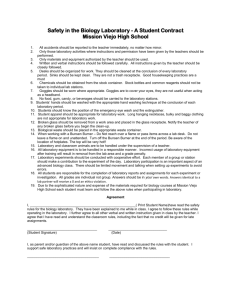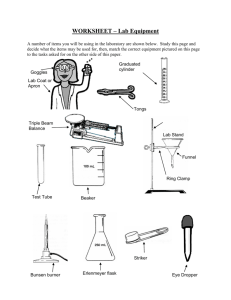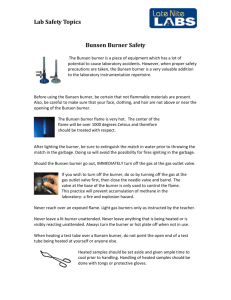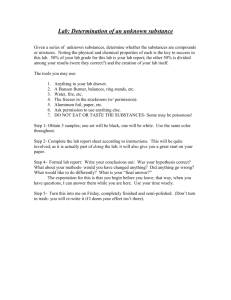word - jpsaos
advertisement
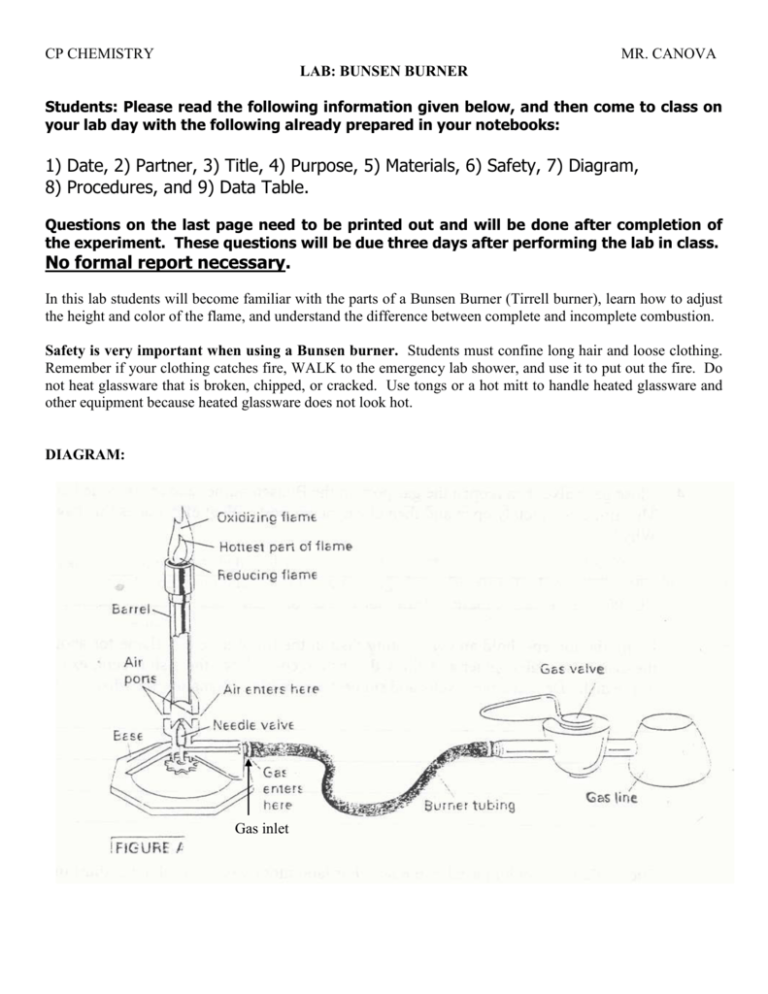
CP CHEMISTRY MR. CANOVA LAB: BUNSEN BURNER Students: Please read the following information given below, and then come to class on your lab day with the following already prepared in your notebooks: 1) Date, 2) Partner, 3) Title, 4) Purpose, 5) Materials, 6) Safety, 7) Diagram, 8) Procedures, and 9) Data Table. Questions on the last page need to be printed out and will be done after completion of the experiment. These questions will be due three days after performing the lab in class. No formal report necessary. In this lab students will become familiar with the parts of a Bunsen Burner (Tirrell burner), learn how to adjust the height and color of the flame, and understand the difference between complete and incomplete combustion. Safety is very important when using a Bunsen burner. Students must confine long hair and loose clothing. Remember if your clothing catches fire, WALK to the emergency lab shower, and use it to put out the fire. Do not heat glassware that is broken, chipped, or cracked. Use tongs or a hot mitt to handle heated glassware and other equipment because heated glassware does not look hot. DIAGRAM: Gas inlet CP CHEMISTRY MR. CANOVA Please copy down (paraphrasing is okay as long as the main idea is understood) the following procedures. Do not place an observation column for your procedures. You will record your observations down in the data section of this lab (see following pages). PROCEDURES: 1. Look at Figure A as you examine your bunsen burner and identify the parts (gas inlet, vertical tube or barrel, adjustable port in the base of the barrel that allows gas to mix with air, and adjustable needle valve to regulate the flow of gas). 2. Twist the needle valve to close it completely. This prevents gas from flowing into the burner. 3. Twist the barrel in the clockwise direction to close the air ports completely. Now twist the barrel in the counter clockwise direction until it detaches from the burner. Carefully re-attach the barrel to the burner and turn it in the clockwise direction until the air ports are completely closed. 4. Make sure your burner tubing is securely connected to the inlet at the base of the burner (this is where the gas enters the burner) and to the gas nozzle at your lab station. Notice that the gas nozzle valve is in the perpendicular position. This is the “OFF” position. See Figure A. SAFETY: Before you light the burner, check to see that you and your partner have taken the following safety precaution against fires: -Wear safety goggles and aprons. -Confine long hair and loose clothing: tie long hair back and roll up long sleeves. -Clear off lab station, leaving only lab equipment, lab sheet, and writing utensil. 5. You will now light the burner. Two people are needed. One person will slightly loosen the needle valve at the base of the burner and slightly open the air ports, and then stand in the aisle. The second person can light the match and bring it along side of the barrel and raise it slowly over the edge, holding it about 2 cm from the top of the burner (keep hand and fingers clear of burner, hold only match over the burner). Once the match is in position, the person in the aisle can now turn the gas valve so that it is parallel to the nozzle (the gas flow is fully on in this position). See Figure A. 6. Once you have a flame that is burning safely and steadily, extinguish the match by running it under cold water and discard it IN THE GARBAGE PAIL, NOT IN THE SINK. 7. Observe the flame and record your observations in the data table. 8. Turn the barrel of the burner counter clockwise to open the air holes even further. Record your observations in the data table. BE CAREFUL NOT TO TURN THE BARREL SO FAR THAT IT DETACHES FROM THE BURNER. 9. Now, completely close the air holes by turning it clockwise. Record your observations in the data table. 10. Turn the needle valve first in one direction and then in another direction. Record your observations in the data table. Finally, turn the needle valve in the correct direction to close it completely. Record your observations in the data table. 11. You will now have to re-light your Bunsen burner. Review step 5 to complete this. CP CHEMISTRY MR. CANOVA 12. Using the crucible tongs, hold an evaporating dish in the tip of a yellow flame for about 3 min. Place the dish on the cooling square and allow the dish to cool. Once the dish is cool, examine the bottom of the dish. Record your observations in the data table. Such a flame is seldom used in the lab. For laboratory work, you should adjust the burner so that the flame is free of yellow color, non-luminous, and also free of the roaring sound caused by admitting too much air. A proper flame should contain a lighter blue inner cone. 13. Adjust the needle valve to regulate the flow of gas so that the flame extends roughly 5 cm above the barrel. Now adjust the supply of air by rotating the barrel until you have a quiet, steady flame with a SHARP DEFINED, LIGHT BLUE INNER CONE. This adjustment gives the highest temperature possible with your burner. Record and sketch your observations in the data table. 14. Using the crucible tongs, insert the piece of copper wire into the flame just above the barrel. Lift the wire slowly up through the flame and try to identify the hottest part of the flame. Hold the wire in this part of the flame for a minute. Record your observations in the data table. LABEL THE HOTTEST PART OF THE FLAME IN YOUR SKETCH IN THE DATA TABLE. 15. Shut off your burner and clean the evaporating dish thoroughly (you might need to use the steel wool, do not wet the steel wool. Place Bunsen burner in your bottom lab door area. Make sure gas valve is in the perpendicular position. 16. Return all the equipment to the teacher. Clean off lab area and wash your hands. Scroll down and copy the table in your lab notebook, and then print it out along with the questions page. The questions must be answered and submitted within 3 days of the completion of this lab. There is no formal typed up lab REPORT for this lab. CP CHEMISTRY Name______________________________________ Period_________________ Lab: Bunsen Burner DATA/OBSERVATIONS: MR. CANOVA Date_____________ Lab Group #_______ Observations Initial Flame After air ports have been opened After air ports have been closed After needle valve has been rotated After needle valve has been closed Evaporating dish after heating Sketch of proper blue flame CP CHEMISTRY Name______________________________________ Period_________________ Lab: Bunsen Burner MR. CANOVA Date_____________ Lab Group #_______ 1. How does adjusting the needle valve on the Bunsen burner affect the flame? 2. How does adjusting the barrel on the Bunsen burner affect the flame? 3. What happens to the flame if the air ports are opened too much? 4. What is the substance that appeared on the bottom of the evaporating dish after it was heated? 5. Where did this substance come from (use answer from question 4 to help with this question)? 6. Using any resources and properly citing them (see my website or go to the library), define complete combustion and write a chemical equation for the complete combustion of methane gas. 7. Using any resources and again properly citing them, define incomplete combustion and write a chemical equation for the incomplete combustion of methane gas. 8. Why is the non-luminous (blue) flame preferred over the luminous (yellow) flame in the laboratory? Use some of your observations in your answer.



